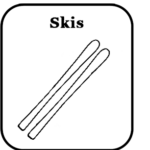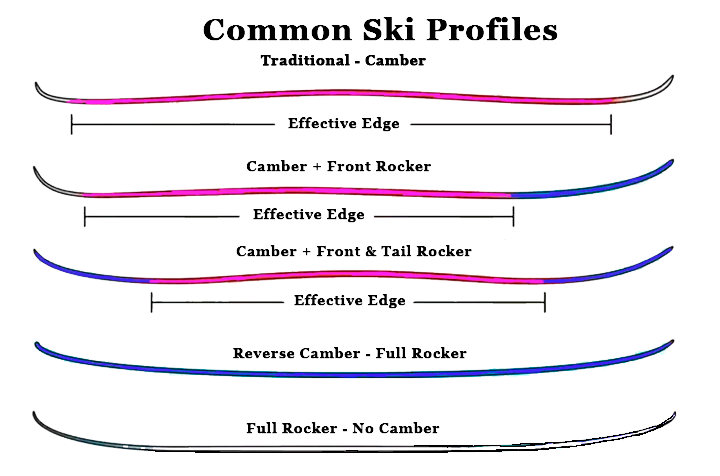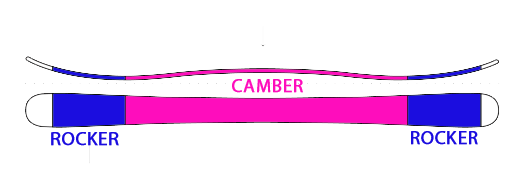Ski Shapes & Profiles

It’s called “ski”ing for a reason.
First principles are the ski manufacturer’s basic methods of crafting a ski for a specific purpose. A powder ski will have shapes and profiles that are radically different than a carving ski. Shape and profile determine ski performance characteristics. You need to know the details of these to help you understand what ski manufacturers have at their disposal. They make the candy, knowing how helps you make better selections.
We cover these in more detail below.
Shape
A ski’s shape is built around tip and tail width. The width of the ski’s tip and tail. Waist width, the width at the ski’s waist. And sidecut (or radius) the curvature created by the tip and tail width.
Almost all skis are now parabolic. In the ski industry, the term means an hourglass shape created with a tip and tail width larger than the waist.

The sidecut or radius created by measuring the curvature of the ski is the sidecut.

Shaped skis create a very specific type of sidecut. The sidecut helps determine the skis turn radius (see Turn Radius for details). Skis can be the same length and have the same tip and tail width and ski very differently because of a different sidecut. In other words, a different shape can create a different sidecut, and that sidecut dramatically changes the characteristics of a ski.

Reverse sidecut is when the radius is convex, from above. This comes right out of the world of surfboards and water skis.

Ski Profiles

The pictures above show skis flat on a surface. The flex pattern between the ski and the surface is commonly called a profile. When the arc is convex, from the surface, the skis profile is described as camber. When the ski is concave and pushes against the surface, the ski’s profile is described as reverse camber. The pink areas in the picture above are camber, the blue, reverse camber (or rocker).
For GNASA purposes, we’ll refer to profiles as camber and rockers.
Camber
Camber is the upward bend in a ski between the snow touch points. The skiers weight presses down on the ski causing the ski to bend at the touch points. That creates a kind of pop or spring where the skiers weight and the camber act in opposite directions to create a quick responding ski.
On hard snow, cambered shaped skis create the best edge hold, stability and rebound.

Rocker
Rocker is upside down camber and often referred to as reverse camber. It allows a ski or board to easily roll. Rocker shapes are common in water sports where turning is everything. Rockers were introduced as manufacturers found that they could create all kinds of edge, grip and torsional precision using design techniques and materials, but didn’t have a simple way to help skiers turn. The rocker solved this.
Rockers also address other issues with cambered skis. Whereas cambered skis are loaded, like a bent spring, rockers are not. On bumps, choppy hard pack or crud, cambered skis vibrate. Rockers are able to absorb the vibrations. They are easier on your body.
Today, full rockers are used for deep powder snow. Originally made famous by K2 Pontoons and Volant Spatulas, these rocker plus reverse sidecut skis allowed skiers to turn effortlessly in deep powder.

Rocker Camber Rocker
In an attempt to get the best of both worlds, quick turning skis and easy turning skis, the camber-rocker combination was created. This is one of the most common profile configuration used today. The rocker to rocker effective edge can be homed for edging. The added rocker allows skiers to quickly initiate turns by using the rockers easy roll characteristics.
Many of the all mountain skis use this pattern. It help facilitate on piste and off-piste skiing. Head Kore, Volkl RTM, Elan’s Ripstick, and Kastle MX series use this profile.

There are other profiles manufactures can use for specific effects. Below are the most common profiles.

Camber + Tip (Front) Rocker
This profile uses a rocker configuration on the tip of the ski and camber behind. The tip rocker helps the ski to initiate turns.
Full Rocker No Camber
Full rockers with no camber skis are usually powder skis that can make turns on hard pack. The enhanced edge is created by flattening the rocket (zero camber).
Stiffness & Flex Pattern
All skis have a stiffness. A decade ago flex pattern conversations were common. Tip, tail and underfoot stiffness would vary a lot and had noticeable effect. Today industry folk generally refer to the stiffness of a ski on a continuum between soft and very stiff. Today manufacturers have so many techniques to address flex patterns that your best bet is to read up and test drive.
The stiffness determines how hard or easy it is to flex the ski. Stiffness is created over the entire surface of the ski. There is a bending stiffness, called longitudinal stiffness and torsional stiffness often called twisting stiffness. These two forces combined determine a skis flex pattern or stiffness.
Manufacturers will tell you about their skis flex pattern. They will generally explain how they create a skis stiffness. It is usually created by ski materials and design techniques. We cover these in the Ski Construction Materials & Ski Construction Sections below.